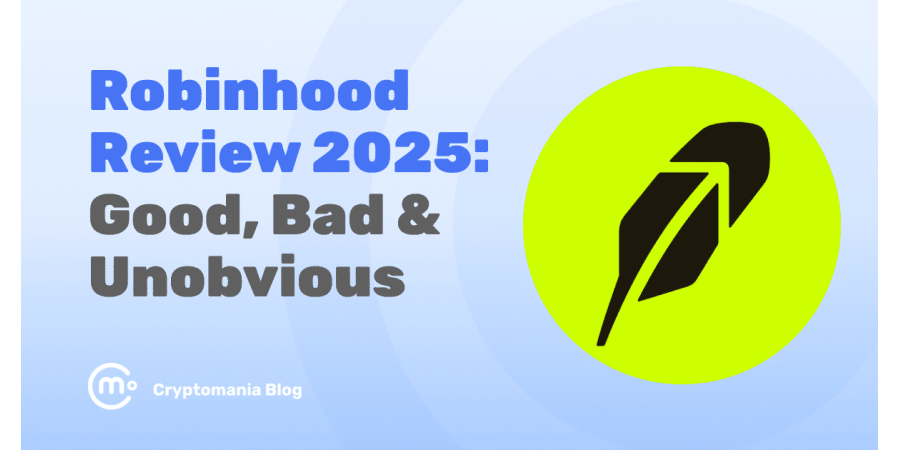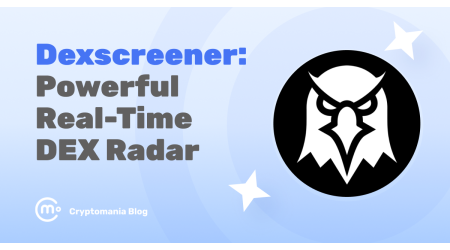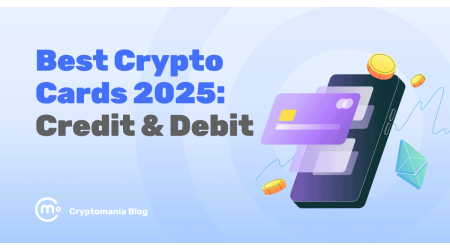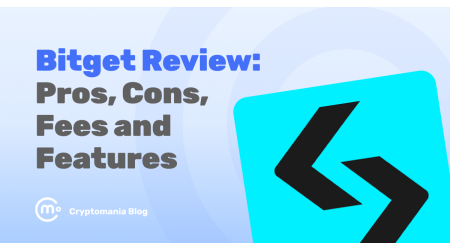

Robinhood’s commission-free trades started a movement. Now, trading crypto on Robinhood is a hot topic in every finance forum, headline, and group chat. It’s the app most people think of when someone mentions investing from their phone.
Users love its clean interface, instant access to stocks and crypto, and the ability to buy fractional shares with very little funds.
But there’s a flip side. Critics call out Robinhood’s limited research tools and revenue streams that reward high trading volume, not necessarily better outcomes for you. And if you’re not looking, it’s easy to miss the fees hiding in plain sight. They’re things like account transfers or margin interest.
In this review, we’ll break down the hype, uncover the real trade-offs, and expose what’s happening behind Robinhood’s bright-green curtain. You’ll learn where Robinhood’s great, where it cuts corners, and what you won’t find in the marketing.
What’s great about Robinhood
Robinhood didn’t just swipe away trading fees. It changed the whole investing script for a new generation:
- Opening trades without commissions
- Rolling out slick mobile tools
- Letting anyone start with pocket change
All these moves made Robinhood the brand most young investors think of when they picture stock trading.
Commission-free trading and accessibility
Before Robinhood, paying a $6-10 commission just to buy one share was the industry norm. That fee hit new investors hardest. Robinhood tore down that wall. No trading fees. No minimum balances. Anyone with a smartphone could buy a single share or even a fraction of one.
- Fractional shares mean you don’t have to be rich to buy big-name stocks. Buy $5 worth of Tesla, not $700 for a full share.
- The app made stocks, ETFs, options, and even buying crypto on Robinhood feel as accessible as ordering a pizza. With just a few taps, you can start trading crypto on Robinhood without needing to know the ins and outs of crypto exchanges.
- Industry-wide effect: Every major US broker dropped commissions within a year of Robinhood’s move. This changes the industry overnight. Established firms had to catch up or lose younger customers.
Robinhood made investing accessible to millions who never would have tried otherwise.
User experience and gamification
Robinhood is built for the phone. The interface runs fast, looks clean, and never floods you with unnecessary data. But what really grabbed users? Gamified elements that drive engagement.
- Animated confetti bursts after your first trade? Check.
- Instant account approvals, sometimes within minutes.
- Colorful, easy-to-use graphics that feel more like a social app than a bank platform.
- An options trading flow so simplified that even first-timers jump in.
Robinhood uses notifications, rewards, and visual cues to keep users coming back. Some love the dopamine hit. Critics argue it encourages impulsive trades. Either way, the user experience breaks the “boring Wall Street” mold.
Rapid account opening and instant deposits
Traditional brokerages often make you wait days for approval. Robinhood trimmed onboarding to almost nothing.
- Sign-up: Most users can open an account and get verified in less than 10 minutes.
- Instant deposits: Start trading with up to $1,000 before your bank transfer even settles.
- For Robinhood Gold users, instant access jumps higher and makes way for bigger and quicker moves.
This speed removes old pain points. Forgot to fund your account for that big IPO? With Robinhood, you can place your trade with a quick tap.
These moves make Robinhood feel less like finance homework and more like a modern app built for regular people. That’s the secret sauce behind its popularity with first-time investors and digital natives.
The hidden costs and risks of Robinhood
Robinhood sells itself on simplicity and “free” trading. That message has hooked a new wave of investors.
But behind the bright interface and zero-commission headlines sit some real costs and risks most users never see. When it comes to crypto, many users don’t realize that Robinhood crypto fees can include hidden spreads.
Here’s what really happens when you click “Buy” (and why it can quietly cost more than you think).
Payment for order flow: What users don’t see
Robinhood’s zero-commission trades aren’t really free. They’re funded by a little-known practice called Payment for Order Flow (PFOF). Here’s the rundown:
- How it works: When you place a trade, Robinhood routes your order to large market makers (think Citadel or Virtu) instead of sending it straight to the exchange. In return, these market makers pay Robinhood a fee.
- Why it matters: This setup can create a hidden incentive. Robinhood wants to maximize its own revenue. That means sending orders where they get paid most, not necessarily where you get the best deal.
- Transparency troubles: Robinhood’s reliance on PFOF caused regulation issues and even lawsuits. Why? Users weren’t always told how these behind-the-scenes payments worked.
- The risk for you: Sometimes, your trade gets filled at a slightly worse price than it would at a “best execution” broker. If you trade a lot, it can add up.
If you ever wondered how commission-free brokers stay in business, PFOF is the answer.
Inferior trade execution and consumer losses
PFOF translates directly into dollars left on the table for regular users.
- Robinhood users often get less favorable prices compared to those at larger, more traditional brokers.
- Numbers to know: At other leading brokers, options trades can receive up to 52% of their price improvement potential. Robinhood clocks in at about 7%. That’s not apples to apples, it’s more like apples to rotten apples.
- Robinhood makes less use of price improvement auctions than its competitors. These auctions can drive down the price you pay (or bump up your selling price) by pitting multiple buyers against each other.
TL;DR: Less price improvement means you actually pay more to buy or get less when you sell. Multiply this over dozens (or hundreds) of trades, and “free” isn’t so free anymore.
Encouragement of risky and high-frequency trading
Robinhood’s design feels more like a game than a stodgy brokerage, and that’s no accident. The “fun” interface has its benefits, as we mentioned earlier. But it also has a dark side: many users end up taking risks they don’t fully understand.
- Instant access, instant temptation: Robinhood gives new users instant deposits (up to $1,000 or more) just for signing up. The money is right there, begging to be traded the moment you get approved.
- Margin accounts by default: Many Robinhood accounts are set up with margin trading enabled. Borrow money to trade? It has a thrill. But it also carries the risk of magnified losses and margin calls. If your stock drops fast, you might owe more than you put in. And then Robinhood can liquidate your holdings without warning.
- Easy options trading: Robinhood is famous (and infamous) for making options trading as simple as ordering fast food. The catch? Options are notoriously complex and risky. Many new users jump in without a clear idea of how quickly things can go south.
- Interface psychology: Through colorful charts, push notifications, and just-in-time nudges, Robinhood keeps you glued. Every little win feels like a dopamine hit. The result: faster trading, more frequent trades, and a higher chance of acting on impulse rather than strategy.
Trading with Robinhood often feels effortless. But that ease can be misleading. The app is engineered to get you clicking (and spending). The more buttons you hit, the more it earns from you.
Robinhood crypto wallet and withdrawals: What you should know
Robinhood now offers a crypto wallet. This is a major upgrade for users who want to move assets off the platform. Still, there are limits. Not every coin is supported for transfer yet, and daily withdrawal caps may apply.
- Does Robinhood have a crypto wallet? Yes, but only for select cryptocurrencies, and you’ll need to verify your identity before using it.
- Can I transfer crypto from Robinhood to Coinbase? You can transfer supported coins from Robinhood to external wallets, including Coinbase, as long as the coin is eligible and you meet withdrawal requirements.
- Robinhood crypto withdrawal: Withdrawals usually take a few minutes to hours, but delays can happen if the network is congested or if you’ve recently made a deposit.
- Transfer crypto from Robinhood to wallet: Go to your crypto tab, select the coin, and hit “Send” to start the transfer. You’ll need the destination wallet address and two-factor authentication enabled.
How Robinhood compares to traditional brokerages
Robinhood puts convenience and low cost front and center. If you want simplified stock, ETF, crypto, or options trading from your phone, it’s hard to beat. But stack Robinhood side-by-side with legacy brokerages like Fidelity, and the trade-offs jump out.
Asset variety, research muscle, user support — all these core features set the pros apart from the newbies. Let’s break down where Robinhood falls short and where it tries to keep up.
Limited choice of assets and research tools
Robinhood’s menu is simple by design. You get access to:
- US stocks and ETFs
- Crypto (over 20 coins)
- Basic options contracts
- Fractional shares
- IRA accounts with a 1% match
But start looking for anything beyond this, and the cracks show. Compare that to Fidelity, which has a heavyweight offering:
- Mutual funds, international equities, and fixed income (bonds and CDs)
- Advanced trading tools: basket orders, stop-loss, trailing stops, and complex conditional orders
- Direct access to IPOs and new issues
- Comprehensive retirement and education savings plans
Let’s be clear: Robinhood skips over things like mutual funds, most bonds, and international stocks. If your investment plan includes income from fixed assets, or you want exposure beyond US markets, you’ll hit a wall.
When it comes to research, the gap widens. Robinhood’s tools feel bare-bones:
- Company news and basic price charts
- Calendar features for earnings and dividends
- The occasional snapshot on analyst ratings (mostly paywalled through Robinhood Gold)
Fidelity, on the other hand, is a research powerhouse:
- In-depth third-party reports from Morningstar, Lipper, and more
- Screening tools for stocks, ETFs, mutual funds, and bonds
- Proprietary and advanced portfolio analysis
- Real-time level II quotes, technical and fundamental analysis
- Smart order routing tested for best execution and price improvement on every trade
For anyone serious about digging into data before hitting “Buy,” Fidelity’s tools create a huge advantage. Robinhood? It’s designed for you to browse, swipe, and execute quickly, not pause, analyze, and strategize.
Robinhood’s lineup works for casual investors and traders who want to keep things basic. But if you’re building a diversified, research-driven portfolio, Fidelity and other established brokers deliver far more firepower.
Investor education and long-term protections
Robinhood appeals to first-timers, so you’d think they’d go big on education. Instead, you get short articles, news snippets, and a few high-level explainers. Most guidance just scratches the surface.
Want to understand options Greeks, mutual fund taxes, or smart asset allocation? Robinhood points you toward FAQs and simple tutorials, but that’s it. Robinhood Gold adds some research reports, but only gives advanced content to those who pay for it.
The platform supports SIPC insurance, protecting up to $500,000 in securities (including $250,000 for cash). They’ve started offering FDIC-insured cash accounts and IRA protections.
But their reputation for handling “unusual” events, such as outages, trading halts, or delayed support, doesn’t inspire full trust for big or long-term investors.
Robinhood wins for simplicity and instant access. But when it comes to breadth, depth, and support, traditional brokers like Fidelity are still the gold standard.
The verdict
Robinhood nails the basics: free trades, clear design, and instant access. This setup works best for new investors and anyone who wants simple, fast trading without the learning curve (or a big upfront deposit). It’s easy to get started. Sometimes, it’s too easy.
Those perks come with strings. Limited research, limited asset selection, and behind-the-scenes costs (like payment for order flow) can eat into what looks free on the surface. Risk ramps up if you’re drawn into rapid trading or option strategies without the full picture.
Choose Robinhood if speed and simplicity are your thing, and you’re fine with a starter toolkit. If you value deep analysis, broad diversification, or more control, look somewhere else. Before you dive in, read the fine print, especially on fees and trade execution.
FAQ
How to trade crypto on Robinhood?
Trading crypto on Robinhood works like trading stocks. Search for the coin, enter the amount, and confirm the trade — no need for a separate exchange account.
Can you day trade crypto on Robinhood?
Yes, you can day trade crypto on Robinhood, and crypto trades don’t fall under the Pattern Day Trader rule. But be cautious. Crypto markets are volatile, and making lots of trades often can rack up fees through spreads.
Is Robinhood safe for crypto?
Robinhood uses industry-standard security measures and stores most crypto in cold wallets. However, it’s still a custodial platform, which means you don’t own the private keys. For full control, consider transferring to your own wallet.





